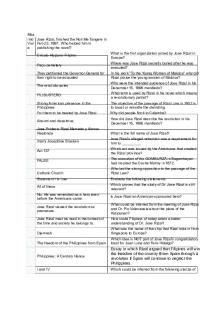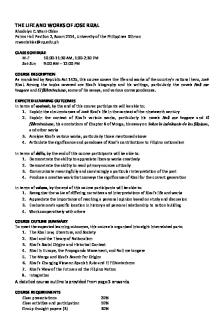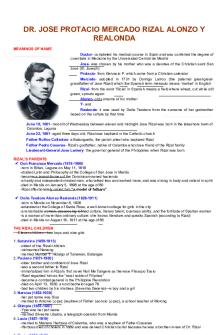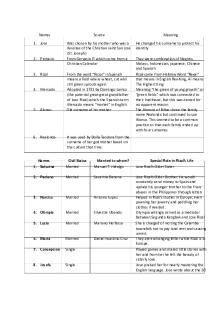Summary Biology: How Life Works - Ch 1-18 PDF

| Title | Summary Biology: How Life Works - Ch 1-18 |
|---|---|
| Course | Biology I |
| Institution | University of Ontario Institute of Technology |
| Pages | 41 |
| File Size | 794.9 KB |
| File Type | |
| Total Downloads | 7 |
| Total Views | 113 |
Summary
CH 1-18...
Description
Chapter 1 Biology – the science of how life works. Biologists – scientists who study life. Observation – is the act of viewing the world around us. Experimentation – is a disciplines and controlled way of asking and answering questions about the world in an unbiased manner. Hypotheses – tentative explanations for questions that arise while observing. Scientific Method – a deliberate and careful way of asking questions about the unknown. Theory – a general explanation of the world supported by a large body of experiments and observations. Four Key Characteristics of Living Organisms: 1. Complexity, with precise special organization on several scales 2. The ability to change in response to the environment 3. The ability to reproduce 4. The capacity to evolve. Cell – the simplest entity that can exist as an independent unit of life. Proteins – they key structural and functional molecules that do the work of the cell. Central Dogma of Biology – the pathway from DNA to RNA to protein. Gene – the DNA sequence that corresponds to a specific protein product. Plasma Membrane – separates the living material from the nonliving environment around it. Nucleus – houses the cell’s DNA. Cytoplasm – a discrete space within the cell separate from the space outside of the nucleus. Prokaryotes – cells without a nucleus. Eukaryotes – cells with a nucleus.
Three Domains of Life: Bacteria, Archaea and Eukarya Three Essential Features of a Cell: 1. The capacity to store and transmit information 2. A membrane that selectively controls movement in and out 3. The ability to harness energy from the environment. Environmental Variation – differences in the environment. Genetic Variation – differences in the genes that are transmitted from parents to their offspring. Tree of Life – full set of evolutionary relationships among all organisms. Ecology – is the study of how organisms interact with one another and with physical environment in nature.
Chapter 2 Ancient Greece – Earth, Fire, Air, Water Each element made up of one atom (basic unit of matter) Dense central section – nucleus Protons – positive Neutron – neutral Nucleus is positively charged Electrons – negative Z=E=P # of neutrons in an element can differ (isotopes) Phosphorus – use to study plants Carbon – for carbon dating One orbital (where an electron is) is for two electrons only Closer – less energy S, P, D, F 2, 8, 16, 32 Electrons have 2 energy levels Elements have different properties Same row - same shells Same column - same # of electrons Valence electrons – farthest from the nucleus (highest energy levels) Merge to form a compound (Merged orbital) Molecular orbital (one orbital, two electrons) [covalent bond] Electronegativity (ability to attract electrons) (left to right, bottom to top) Shared unequally (polar covalent bond) (no sharing [dotted lines])
Ionic bond (extreme case) Very electronegative steals Opposite charges (ions) Intramolecular (outside) – covalent, ionic Intermolecular (inside) – hydrogen, hydrophobic, van der Waals Bond energy – energy needed to separate a bond 60 elements were known in 1850 Today 118, 94 occur naturally, 24 created artificially in the lab Hydrogen – water former Hydrophilic – polar Hydrophobic – nonpolar Hydrogen and helium – most abundant elements in the universe Carbon containing molecules – organic molecules Isomers – same formula, different structures Proteins provide structural support and acts as catalysts for chem reactions Nucleic acids encode and transmit genetic info Carbs provide source of energy, make up the cell wall Lipids make up cell membrane, store energy, and signals Polymers – complex molecules made of simpler ones connected by covalent bonds Proteins – poly of amino acids Nucleic acids – made of nucleotides Carbs – built from simple sugar Fatty acids – components of lipid membranes that define cell boundaries Enzymes accelerate the rate of chem reactions
Protein structure: (alpha carbon is linked to carboxyl group, amino group, r-group (side chain), and hydrogen atom) DNA – genetic material in all organisms RNA – key player in protein synthesis and regulation of gene expression Nucleotides components: 5 – carbon sugar, nitrogen containing compound (base), one or more phosphate groups RNA sugar – ribose (HO) on second carbon DNA sugar – deoxyribose (H) on second carbon Pyrimidine bases (single ringed) – T, C & U Purine bases (double ringed) – A & G Phosphodiester bond forms when a phosphate group is joined to a sugar unit in another nucleotide Formation of phosphodiester bond involves loss of water DNA – 2 strands of nucleotides in double helix (sugar phosphate backbones are around the double helix while bases are pointed inward) Complementary (purine-pyrimidine) Base pairing results from hydrogen bonding between bases Simplest carbs – saccharides Glucose (product of photosynthesis) Galactose (found in dairy products) Fructose (commercial sweetener) Monosaccharide (in ring form) – unbranched carbon chains with either an aldehyde or ketone. Monosaccharide with an aldehyde group are aldoses and those with ketone are ketoses. Starch is composed of glucose molecules while pectin, component of the cell wall, contains up to five monosaccharides.
Glycosidic bonds – covalent bonds that attach monosaccharides together (needs dehydration). It is formed between carbon 1 of a monosaccharide and an OH group Disaccharide – Sucrose (made up of glucose and fructose) or table sugar Polysaccharide – provide long term storage (starch and glycogen) or structural support (cellulose) Complex carbs – long, branched chains of monosaccharides Triaglycerol – a lipid used for energy storage. Major component of animal fat and vegetable oil. It is made up of three fatty acids join to a glycerol. Saturated are those who do not contain double bonds Unsaturated are those that contain carbon-carbon double bonds Van der Waals forces – polarized molecules weakly bind to one another because of the attraction of opposite charges. As the hydrocarbon chains increases, VdW bonds increases, and increases the melting temperature. Steroids (such as cholesterol) 2nd type of lipids. Cholesterol has a core of 20 C atoms bonded forming four fused rings and is hydrophobic. Phospholipids (3rd type) – major component of the cell membrane. Made up of glycerol attached to two fatty acid chains and a 3rd molecule with a phosphate group. Head is hydrophobic and tail is hydrophilic (they are amphipathic). Bilayer – two-layered structure with hydrophilic heads pointing outward and hydrophobic heads oriented inward.
Chapter 3 Replication -allows the genetic information from one DNA molecule to be copied into that of another DNA molecule. Mutation - a change in the genetic information in DNA. Transcription – the process in which the genetic information in a molecule of DNA is used as a template, or pattern, to generate a molecule of RNA. The term “transcription” is used because it emphasizes that both molecules use the same language of nucleic acids. It is the first step in gene expression, which is the production of a functional gene product. Translation – the second step in the readout of genetic information in which a molecule of RNA is used as a code for the sequence of amino acids in a protein. The term “translation” is used to indicate a change of languages, from nucleotides that make up nucleic acids to amino acids that make up proteins. Nucleotides – DNA’s subunits. Its three components are a 5-carbon sugar, a base, and one or more phosphate groups. Nucleoside – a combination of sugar and a base. Phosphodiester Bond - a relatively stable bond that can withstand stress like heat and substantial changes in pH that would break weaker bonds. The succession of phosphodiester bonds traces the backbone of the DNA strand. Supercoils – the event in which the circular molecule coils upon itself, much like what happens to a rubber band when you twist it between your thumb and forefinger. Topoisomerases – enzymes that cause supercoiling by cleaving, partially unwinding, and reattaching a DNA strand, which puts strain on the DNA double helix. Chromatin – chromatin fibers of 30-nm chromatin fiber or 10-nm chromatin fiber. Nucleosome – beadlike repeating unit of the 10-nm chromatin fiber. RNA polymerase – the enzyme that carries out polymerization. Sigma Factor – a protein which associates with RNA polymerase and facilitates its binding to specific promoters. General Transcription Factors – six proteins that assemble at the promoter of a gene.
Pol II – the RNA polymerase complex responsible for transcription of protein-coding genes in eukaryotes. Polycistronic mRNA – molecules of mRNA that code for multiple proteins. RNA processing – converts the primary transcript into finished mRNA. Polyadenylation - the addition of a string of about 250 consecutive A-bearing ribonucleotides to the 3′ end, forming a poly (A) tail. RNA splicing – process of intron removal. Alternative splicing – process in which primary transcripts from the same gene can be spliced in different ways to yield different mRNAs and therefore different protein products. Ribosomal RNA (rRNA) - found in all ribosomes that aid in translation. Transfer RNA (tRNA) - carries individual amino acids for use in translation. Small nuclear RNA (snRNA) - found in eukaryotes and involved in splicing, polyadenylation, and other processes in the nucleus. MicroRNA or miRNA - small, regulatory RNA molecules that can inhibit translation. Small Interfering RNA or siRNA – RNA that can cause destruction of an RNA transcript.
Chapter 4 Peptide Bond – bond form between two amino acids. Polypeptide – a polymer of amino acids connected by peptide bonds. Amino Acid Residues – amino acids that are incorporated into a protein. Primary Structures – the sequence of amino acids in a protein. Secondary Structures – structures formed by interactions between stretches of amino acids in a protein. Tertiary Structures – three-dimensional shape supported by longer-range interactions between the secondary structures. Quaternary Structures – structures made up of several individual polypeptides that interact with one another. Chaperones – proteins that help protect slow-folding or denatured proteins until they can attain their proper three-dimensional structure. Aminoacyl tRNA synthetases – connect specific amino acids to specific tRNA molecules. Folding domain – a region of protein that folds in a similar way relatively independently of the rest of the protein. Mutation – a change in the sequence of a gene.
Chapter 5 Liposomes – enclosed bilayer structures spontaneously formed if phospholipids are added to a test tube of water at a neutral pH. Cholesterol increases or decreases membrane fluidity. Lipid Rafts – defined patches that specific types of lipids assemble into. Lipid Flip Flop – the spontaneous transfer of a lipid between layers of the bilayer. Transporters – membrane proteins that moves ions or other molecules across the membrane. Channels – membrane proteins that allow movement of molecules. Carriers – membrane proteins that facilitate movement. Receptors – membrane proteins that allow the cell to receive signals from the environment. Enzyme – membrane proteins that catalyze chemical reactions. Anchors – membrane proteins that attach to other proteins that help to maintain cell structure and shape. Integral Membrane Proteins – permanently associated with cell membranes and cannot be separated from the membrane itself. Most integral membrane proteins are transmembrane proteins. Peripheral Membrane Proteins – temporarily associated with the lipid bilayer or with integral membrane proteins through weak noncovalent interactions. They are easily separated from the membrane by simple experimental procedures that leave the structure of the membrane intact. Fluid Mosaic Model – the model that states that the lipid bilayer is a fluid structure that allows molecules to move laterally within the membrane, and is a mosaic (a mixture) of two types of molecules, lipids and proteins. Plasma Membrane (Cell Membrane) -is a fundamental, defining feature of all cells. It is the boundary that defines the space of the cell, separating its internal contents from the surrounding environment. But the plasma membrane is not simply a passive boundary or wall. Cell Wall – is external to the plasma membrane and plays an important role in maintaining the shape and internal composition of these cells.
Homeostasis – the active maintenance of a constant environment and is a critical attribute of cells and of life itself. Selective Barrier - the plasma membrane lets some molecules in and out freely; it lets others in and out only under certain conditions; and it prevents still other molecules from passing through at all. Diffusion - is the random movement of molecules. Facilitated Diffusion – is when a molecule moves by diffusion through a membrane protein and bypasses the lipid bilayer. Aquaporins – protein channels which allow water to flow through the plasma membrane more readily by facilitated diffusion. Osmosis – the diffusion of a solvent across a selectively permeable membrane. Active Transport - the "uphill" movement of substances against a concentration gradient and this needs energy. Primary Active Transport – active transport that uses energy directly. Electrical Gradient – the difference in charge. Electrochemical Gradient – the charge and chemical gradients. Secondary Active Transport – the movement of the coupled molecules is driven by the movement of protons and not by ATP directly. Contractile vacuoles - compartments that take up excess water from inside the cell and then, by contraction, expel it into the external environment. Turgor Pressure (Hydrostatic Pressure) – pressure that resulted from the force exerted by water pressing against objects. Nucleoid – a discrete region of the cell interior where the DNA is concentrated. Plasmids – small circular molecules of DNA that carry a small number of genes. Pili (singular, pilus) – threadlike, hollow structures which extend from one cell to another. Organelles - divide the cell contents into smaller spaces specialized for different functions. Endoplasmic Reticulum (ER) - is involved in the synthesis of proteins and lipids.
Golgi Apparatus - modifies proteins and lipids produced by the ER and acts as a sorting station as they move to their final destinations. Lysosomes - contain enzymes that break down macromolecules such as proteins, nucleic acids, lipids, and complex carbohydrates. Mitochondria (singular, mitochondrion) - are specialized organelles that harness energy for the cell. Cytoskeleton – protein scaffold that helps cells to maintain their shape and serves as a network of tracks for the movement of substances within cells. Some cells even move with the help of the cytoskeleton. Chloroplasts – convert energy of sunlight into chemical energy. Cytoplasm – entire contents of a cell other than the nucleus. Cytosol – the region of the cell inside the plasma membrane but outside the organelles. Vesicles – small membrane-enclosed sacs that transport substances. Nuclear Envelope – defines the boundary of the nucleus. Nuclear Pores – protein openings. Lumen – interior of the ER. Rough Endoplasmic Reticulum (RER) – small, rounded particles associated with the ER that are exposed to the cytosol. Ribosomes – particles bound to the cytosolic face of the RER. Small Endoplasmic Reticulum (SER) – small amount of the ER membrane that lack ribosomes. Roles of the Golgi Apparatus: 1. It further modifies proteins and lipids produced by the ER 2. It acts as a sorting station as they move to their final destinations 3. It is the site where most of the cell’s carbohydrates are synthesized Cisternae – series of flattened membrane sacs. Lysosomes – specialized vesicles derived from the Golgi apparatus that degrade damaged or unneeded macromolecules. Protein Sorting - the process by which proteins end up where they need to be to perform their function.
Signal Sequences- directing of the proteins to their proper cellular compartments by means of particular amino acid sequences. Nuclear Localization Signal - signal sequence for the nucleus that enables proteins to move through pores in the nuclear envelope. Signal-recognition Particle (SRP) - RNA–protein complex. Thylakoid – internal membrane-bound compartment.
Chapter 6 ATP(Adenosine Triphosphate) – the energy used by cells. -
Universal currency of cellular energy
6.1 AN OVERVIEW OF METABOLISM Phototrophs – organisms that capture energy from sunlight Chemotrophs – organisms that derive their energy directly from organic molecules such as glucose Autotrophs (self-feeders) – organisms that make their own organic source of carbon Heterotrophs (other feeders) – organism that rely on other organisms for their organic source of carbon Metabolism – building and breaking down of sugars and harnessing and release of energy in the process -
entire set of chemical reactions that convert molecule into other molecules and transfer energy in living organism.
Catabolism – set of chemical reactions that break down molecules into smaller units and produce ATP Anabolism – set of chemical reactions that build molecules from smaller units and require and input of energy (ATP) 6.2 ENERGY Energy – system’s capacity to do work Kinetic energy – energy of motion Potential energy – stored energy 6.3 LAWS OF THERMODYNAMICS First Law of Thermodynamics (Law of Conservation of Energy) -
Universe contains a constant amount of energy
-
Energy is neither created nor destroyed
-
Energy simply changes from one form to another
Second Law of Thermodynamics -
When energy changes form, the total amount of energy remains constant
-
In going from one form of energy to another, the energy available to do work decreases
Entropy – degree of disorder Thermal energy – form of kinetic energy corresponding to the random motion of molecule and results in a given temperature 6.4 CHEMICAL REACTIONS Chemical reactions are subject to the laws of thermodynamics. Gibbs free energy (G) – amount of energy available to do work Exergonic – reactions with a negative ∆G that release energy and proceed spontaneously Endergonic – reactions with a positive ∆G that require an input of energy and are not spontaneous Enthalpy (H) - total amount of energy Total amount of energy (H) = energy available to do work (G) + energy lost to entropy (TS) Energetic coupling – coupling in which a spontaneous reaction drives a nonspontaneous one and it provides the thermodynamic driving force of a nonspontaneous biochemical reaction 6.5 ENZYMES AND THE RATE OF CHEMICAL REACTIONS Enzymes – catalysts that are proteins Transition state – the intermediate stage between reactants and products -
It is highly unstable and therefore has a large amount of free energy
Activation energy (EA) – energy input necessary to reach the transition state
Substrate (S) – is a reactant converted into a product (P) in an uncatalyzed reaction Active site – is the portion of the enzyme that binds substrate and converts it to product Inhibitors – decrease the activity of enzymes Activators – increase the activity of enzymes Irreversible inhibitors – usually form covalent bonds with enzymes and irreversibly inactivate them Reversible inhibitors – form weak bonds with enzymes and easily dissociate from them Competitive inhibitors – bind to the active site of the enzyme and prevent the binding of the substrate Non-competitive inhibitors – have a structure different from that of the substrate and bind to the enzyme at a site different from the active site Negative feedback – the final product inhibits the first step of the reaction Allosteric enzymes – bind to activators and inhibitors at site that are different from the active site, resulting in a change in the shape and activity of the enzyme
VIDEO Energy – system’s capacity to do work Source of energy on earth – sun Energy is stored in chemical bonds on the cellular level Kinetic energy – energy used ...
Similar Free PDFs

Life Works
- 4 Pages

LIFE-AND- Works-OF- Rizal- Summary
- 73 Pages

Rizal life and works
- 15 Pages

Life works of rizal
- 12 Pages

Rizal’s Life and Works
- 82 Pages

Life and Works of Rizal
- 57 Pages

Syllabus Rizal Life and Works
- 13 Pages

Jose Rizal Life and Works
- 35 Pages

BUS 359 how google works
- 3 Pages

Life and Works of Rizal
- 16 Pages

Life and works of rizal
- 3 Pages

PHIL 1109 How Science Works
- 29 Pages
Popular Institutions
- Tinajero National High School - Annex
- Politeknik Caltex Riau
- Yokohama City University
- SGT University
- University of Al-Qadisiyah
- Divine Word College of Vigan
- Techniek College Rotterdam
- Universidade de Santiago
- Universiti Teknologi MARA Cawangan Johor Kampus Pasir Gudang
- Poltekkes Kemenkes Yogyakarta
- Baguio City National High School
- Colegio san marcos
- preparatoria uno
- Centro de Bachillerato Tecnológico Industrial y de Servicios No. 107
- Dalian Maritime University
- Quang Trung Secondary School
- Colegio Tecnológico en Informática
- Corporación Regional de Educación Superior
- Grupo CEDVA
- Dar Al Uloom University
- Centro de Estudios Preuniversitarios de la Universidad Nacional de Ingeniería
- 上智大学
- Aakash International School, Nuna Majara
- San Felipe Neri Catholic School
- Kang Chiao International School - New Taipei City
- Misamis Occidental National High School
- Institución Educativa Escuela Normal Juan Ladrilleros
- Kolehiyo ng Pantukan
- Batanes State College
- Instituto Continental
- Sekolah Menengah Kejuruan Kesehatan Kaltara (Tarakan)
- Colegio de La Inmaculada Concepcion - Cebu



